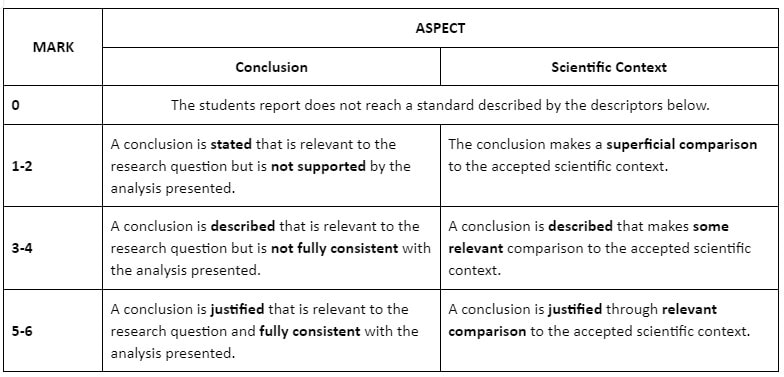Internal Assessment Conclusion
This criterion assesses the extent to which the student successfully answers their research question with regard to their analysis and the accepted scientific context.
- Click for the summary of IB internal assessment requirements.
- Click for a printable score sheet
Command terms indicate the depth of treatment required to earn the different marks.
- State: Give a specific name, value or other brief answer without explanation or calculation.
- Describe: Give a detailed account.
- Justify: Give valid reasons or evidence to support an answer or conclusion.
CONCLUSION
A conclusion that is fully consistent requires the interpretation of processed data including associated uncertainties.
Conclusion Statement
Check list:
Consistency with Analysis
Check list:
A conclusion that is fully consistent requires the interpretation of processed data including associated uncertainties.
Conclusion Statement
Check list:
- State the most important outcome of the investigation
- The conclusion refers back to the research question
- The conclusion avoids being too definitive or over-generalizing
- The extent to which the hypothesis is supported by the data is explained
- Avoid reference to “proof” of “proves”
Consistency with Analysis
Check list:
- The need/importance/relevance of the research question is clear
- The conclusion is correct and clearly supported by the interpretation of the data
- Key data from the analysis is given and trends in the data are discussed
SCIENTIFIC CONTEXT
Scientific context refers to information that could come from published material (paper or online), published values, course notes, textbooks or other outside sources. The citation of published materials must be sufficiently detailed to allow these sources to be traceable.
Scientific Context
Check list:
Scientific context refers to information that could come from published material (paper or online), published values, course notes, textbooks or other outside sources. The citation of published materials must be sufficiently detailed to allow these sources to be traceable.
Scientific Context
Check list:
- Scientific explanation for the results is described
- Comparison is made with published data and theoretical texts (with citations)
- Evidence from published material is utilized for comparison
